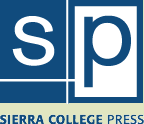From The Gregson Memoirs, containing Mrs. Eliza Gregson's ‘Memory’ and the statement of James Gregson
Eliza Marshall Gregson
San Francisco, Printed by L.R. Kennedy, 1940 -- Reprinted from California Historical Society Quarterly, vol. XIX, no. 2, June 1940
Eliza Marshall Gregson, a millworker, and her husband James Gregson, a blacksmith, were natives of England who married in Rhode Island in 1843 and almost immediately began planning to move West. In 1845, they set out for Oregon, eventually joining a California wagon party. The imperious master of New Helvetia (later Sacramento) John Sutter aided them, and the Gregsons lived at his fort until 1847. James Gregson enlisted in the U.S. Army under John C. Frémont in 1846.
After his war service, James Gregson was employed by Sutter and James Marshall to help build a sawmill in Coloma along the banks of the American River in the Sierra Nevada foothills. It was at this mill that Marshall, the co-owner and manager of the sawmill, discovered gold on January 24, 1848, and ushered in the California Gold Rush.  James Gregson prospected for gold in 1848 and 1849 while his wife bore and raised their children. To support the family Eliza took in washing and sewing jobs. In 1850, the family settled on a ranch in Sonoma County. The Gregson Memoirs (published in 1940) prints James Gregson's brief “Statement” of the facts of his life and his wife's longer “Memory” of her experiences during the California Gold Rush era.
James Gregson prospected for gold in 1848 and 1849 while his wife bore and raised their children. To support the family Eliza took in washing and sewing jobs. In 1850, the family settled on a ranch in Sonoma County. The Gregson Memoirs (published in 1940) prints James Gregson's brief “Statement” of the facts of his life and his wife's longer “Memory” of her experiences during the California Gold Rush era.
In this passage from her “Memory,” Eliza Gregson describes her arrival in Coloma in early 1848 and her description of events involving sawmill workers, prospectors and the local Native Americans.
Coloma
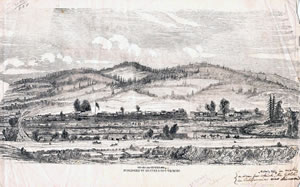 It was about Dec 1847 when the mill stones were finished the grist mill was being built on the American river about 3 miles across in an easterly direction from the fort. At this time Sutter engaged my husband and I to go to Coloma. My husband to be the blacksmith for a saw mill which was being built by Capt Sutter and James Marshall. Myself to cook for the hands which were about 15 men. One man by the name of Bennet, the others I have forgotten. Well a day or two before we started which was about the last day of Dec….The weather was rather bad and it took us two days and a half to make the trip. We reached our destination just about 11 A.M.
It was about Dec 1847 when the mill stones were finished the grist mill was being built on the American river about 3 miles across in an easterly direction from the fort. At this time Sutter engaged my husband and I to go to Coloma. My husband to be the blacksmith for a saw mill which was being built by Capt Sutter and James Marshall. Myself to cook for the hands which were about 15 men. One man by the name of Bennet, the others I have forgotten. Well a day or two before we started which was about the last day of Dec….The weather was rather bad and it took us two days and a half to make the trip. We reached our destination just about 11 A.M.
The Indians that were about had never seen a white child, and it was soon noised abroad that there was a white child on the place and the Indians came from a distance of 40 miles to see her. They would come to the door and look and then they would cover their faces with their hands, and were very much astonished at the sight. they even went so far as to pinch her shoulders & pull her hair to see if she was a real human they were very fond of her one squaw wanted me to swap babes with her.
Visiting Other Women
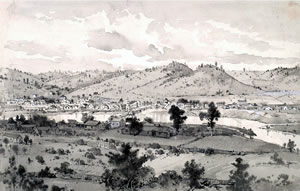
after a week or two we heard that the mineral that was taken out of the tailrace of the sawmill [was gold] & the hands would occasanale bring in a little gold dust after a while I got tired of seeing nothing but squaws & I wanted to see a white woman again so they took me and my child about 15 miles to a place I think it was the dimond springs to see Mrs Wimmer & her family
stayed two days & nights & then returned home. Well I found her camping out and Sleeping in the wagon. she was very glad to see me and we did not sleep very much, but put in the time talking while I stayed, which was two days and nights, and then I returned home. She showed we while there a nugget of pure gold nearly as large as my thumb. William Scott who had been stopping with the wimmer family had found it the last of January 1848, and there was no gold excitement at that time.
The exact date on which gold was really discovered, I am unable to state as it was some time before we could believe that it was real gold. In a few days however after we got settled at Coloma The work hands were digging the tail race at the mill, and one evening they had turned on the water so as to sluice out the dirt. The next morning Jas Marshall and Pete Wimmer were standing on the bank examining the work, when Marshall said to Wimmer, “What is that glittering down in the tail-race?” Wimmer jumped down and picked up some substance, which proved to be fine scale gold, and there was no other kind of gold found in that place, as we afterwards learned. The work hands would occasionally bring in a little gold dust.
Gold?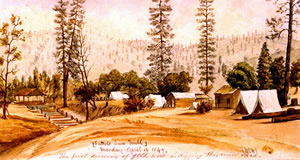
about this time there was a man named humphrys he was a minealoligist [mineralogist] & so [when] the weathre opned out people began to come into the mines one man by the name of turner [came] & brought his daughter Mary & I persuaded him to leave her with me untill he went to bring the rest of his family & he did so which pleased me very much She was about 16 years old. one day as our work was done we went down to the mill which was about half a mile down the hill. & we thought we would wash out some dirt & try to find gold well we saw something shining in the bottom of the tailrace so we got down & gathered some. but turning to my companion I said this is too light & if we take this up to the house the men will laugh at us so we went home no better than we was.
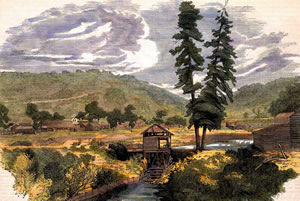
by & by her parents moved into the mines & camped close by us. I must say here that for about 3 months we our liveing was very poor We had salt beef so poor & salty that it looked like blue flint—& salt Salmon too salty & oily that it was not fit to eat & boild barley sometimes boiled wheat & peas dried neither bread or Coffee or tea or sugar. 1 keg of Butter strong enough to run away of itself so that is the way we lived for about 3 months.
about this time gold hunters began to arive with pans & in A short time the new[s] began to spread far & wide about the first of May some men came up from Sonoma & told me that my little sister Mary Ann was married to a Doc. Ames an assistant Doc in the N.Y. Volunteers she being only a little past 13 years old.
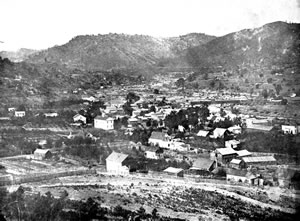
somewheres about this time old James Marshall & J gregson went prospecting for gold a little further up the river than they had been and they found plenty of scale gold my husband asked Marshall to divide with him.
he very quickly answered no you are working for me. Very well says gregson I will work no more & I shall gather gold for myself which he did now the people were coming in from all parts of the of Call & chili & by & by the oragononians commencing to arive early in the gold excitement Mr Gregson made the first pick & afterwards made a good many picks & drills for the miners. & the men stopt working on the mill every thing was gold crazy run away sailors and solders came into the mines my mother & two brothers & my sister came to hunt for gold. my sisters husband had deserated & she did not know where he was at that time.
